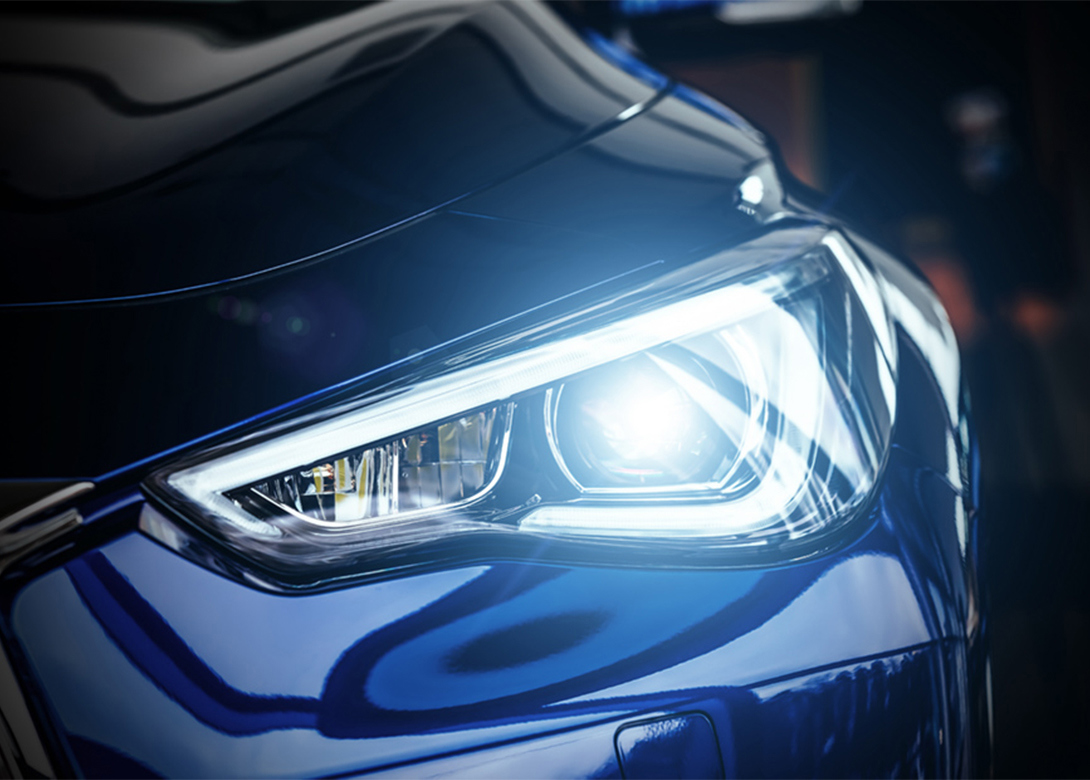
The headlamps and rear lights of passenger cars and commercial vehicles are not only important design elements but, as components of assistance systems, also fulfil increasingly complex functions. To ensure that electrical and electronic components are reliably protected from environmental influences throughout their entire life cycle, the components must be well sealed.
The adhesives used play a key role in this - they must meet the requirements for durability and resistance, but must not be visible, especially in the headlamps’ “field of vision”. The increasing use of large and complex components also poses a challenge in production. In order to meet the high-quality standards laid down by HELLA GmbH & Co KGaA, a manufacturer of lighting systems, for the bonding and sealing of its headlamps and rear lights, WEVO-CHEMIE GmbH has developed products that facilitate both freedom in design and efficient production.
The developments in the field of intelligent headlamp systems are manifold - functions such as matrix lights, light signatures or dynamic indicators require additional electronics that need to be integrated into the component and protected against environmental factors. The components used – ranging from control electronics to LED drivers – also lead to a shift in the location of the heat sources away from the lamps and the direction in which they radiate to the rear of the headlamps. This means increasing demands on the materials used, which need to be both heat dissipating and heat resistant.
The production process is also more complex, because the value of headlamps and rear lights as key brand identification features is resulting in complex component geometries, especially in the premium segment. To be able to manufacture the components with the desired designs, the adhesives deployed need to be specially adapted to the process; in the majority of cases, ‘off the shelf’ systems are simply unable to satisfy the requirements in terms of viscosity, thixotropy and pot life.
To meet the technical and aesthetic requirements for headlamps and rear lights, the company uses potting and adhesive systems from WEVO. Among other things, HELLA works with specially adapted variants of the polyurethane-based WEVOPUR 801 that have been developed in close cooperation between the two companies’ product development departments specifically to fulfil the requirements of the respective components. This results in a number of positive options compared to conventional systems.
For instance, complex geometries of LED and matrix headlamp systems can be realised by adjusting the reactivity and flow properties of the adhesive systems. WEVOPUR 801 is used close to the headlamps’ visible area or “field of vision” – this demands the perfect combination of low viscosity during application with fast setting and good wetting for downstream processing. The specific circumstances of the design and structure of the headlamps need to be taken into account, while still guaranteeing high process quality with regard to application, adhesion and further processing. On the other hand, cable runs and electronic components at the rear of the headlamps and rear lights are potted. In this case, the system used must above all offer sufficient flowability to prevent bubbles and other inclusions from forming. In addition, modified thixotropies ensure the adhesive does not flow through cavities into the interior of the headlamp.
In both of these cases, the subsequent tightness of the seal plays an important role, because the electrical and electronic components must be reliably protected against environmental influences. The moisture and gas tightness of the lamp housing is also of ever greater importance, because unlike halogen or xenon headlamps, the illuminants in LED headlamps no longer heat up the headlamp lens; this can lead to condensation or even icing-up inside the headlamp if air or moisture is able to ingress the lamp unit. Furthermore, the WEVO solutions have been optimised in terms of their thermal conductivity and heat resistance so that the heat losses of the illuminants can be dissipated to the lamp housing, ensuring the lamps’ long-term functionality.
Another trend, especially in the premium segment, is the use of large components such as rear light strips. On the one hand, these involve three dimensional geometries, which in turn means not only horizontal, but also vertical and diagonal surfaces need to be wetted during the application process. This requires optimum coordination of flow characteristics and stability. Since these light strips often extend across the entire width of the vehicle, pot life and reactivity also play a greater role. Bead lengths of more than 2m result in longer application times. In order to wet both housing sections well, the open time of the system must be adjusted accordingly; rapid curing can then follow to minimise the holding times and ensure efficient production.

Having spent a decade in the fastener industry experiencing every facet – from steel mills, fastener manufacturers, wholesalers, distributors, as well as machinery builders and plating + coating companies, Claire has developed an in-depth knowledge of all things fasteners.
Alongside visiting numerous companies, exhibitions and conferences around the world, Claire has also interviewed high profile figures – focusing on key topics impacting the sector and making sure readers stay up to date with the latest developments within the industry.
Don't have an account? Sign Up
Signing up to FastFixTechnology.com enables you to manage your account details.